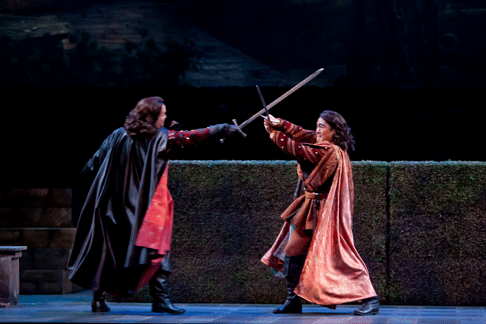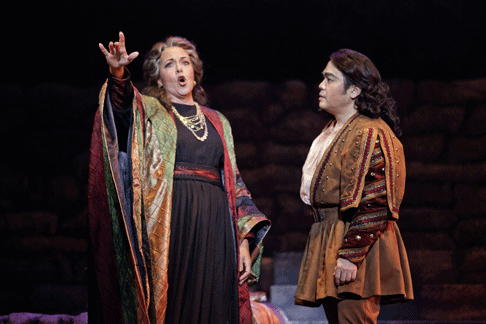11 Mar 2013
Il Trovatore at Arizona Opera
Giuseppe Verdi and his librettist, Salvatore Cammarano, based the opera on Antonio García Gutiérrez’s Spanish play El Trovador.

Giuseppe Verdi and his librettist, Salvatore Cammarano, based the opera on Antonio García Gutiérrez’s Spanish play El Trovador.
It’s important to realize that the play sets the time of the action in the fifteenth century, the time of Ferdinand and Isabella, and of Columbus. Beliefs, customs, and relationships were very different then. People believed that a witch could make you sick by giving you the evil eye. It was an age when few lived beyond the age of forty. Women had almost no rights and more than thirty percent of children died before the age of four. Aspects of the plot that may seem outlandish now, were quite real in the fourteen hundreds.
Unfortunately, Cammarano died before completing his libretto. Verdi then took over revising it and asked Leone Emanuele Bardare to finish it. In doing so, he added a great deal to the leading soprano part. On 19 January 1853 the opera was premièred at the Apollo Theater in Rome. Rigoletto had been a tremendous success in 1851 and Il trovatore was Verdi’s next blockbuster. It swept through European musical capitals like wild fire. By 1855 it was being performed at the recently opened Academy of Music in New York and at Covent Garden in London. Two years later L’Opéra staged Verdi’s Paris version of the opera with a newly written ballet scene.
 Count (Malcolm MacKenzie) duelling with Manrico (Dongwon Shin)
Count (Malcolm MacKenzie) duelling with Manrico (Dongwon Shin)
On 2 March 2013 Arizona Opera presented a traditional production of Verdi’s Il trovatore directed by John Hoomes at Symphony Hall in Phoenix. Actually, since a brand new rear projection screen supplied much of the scenery, it only looked traditional. Technically, it was up to the minute even though the audience was looking at Projection Designer Douglas Provost’s glorious images of fifteenth century Spain.
The first character heard in the opera is the soldier, Ferrando, recounting important background information. When a play is made into an opera only one-third of the dialogue can be used so someone has to recount some of the story. Director Hoomes saw to it that we always knew what was happening. Verdi made that bit of history into a catchy aria and Peter Volpe sang it with vigorous bronze tones. Karen Slack, who sang Leonora, the much fought over heroine, has a voluptuous soprano voice with silvery top notes and a formidable chest register. She seemed to throw care to the winds as she successfully navigated her music’s many pitfalls. The result was an exciting performance of this difficult role. Dongwon Shin was an energetic troubadour with a warm tenor voice, naturally musical phrasing and more than enough squillo for ‘Di quella pira’. He excelled in a role that few tenors attempt, so it’s no wonder that he has sung it in many cities.
 Azucena (Mary Phillips) and Manrico (Dongwon Shin)
Azucena (Mary Phillips) and Manrico (Dongwon Shin)
Mary Phillips had an amazing grasp of the role of Azucena. Verdi himself told us that she was not crazy, but her actions are that of a very troubled woman. These days we might blame it on traumatic stress resulting from having seen her mother’s fiery execution. Phillips made her real and totally believable, both when she showed her love for her presumed son and when she spat like a caged animal during her capture. Phillips colored her opulent mezzo-soprano voice with the myriad textures of this dramatic part. Some of the best singing in this delightful performance came from the villain, Count di Luna, portrayed by Malcolm MacKenzie. He phrased with great artistry and his sound was pure gold. He will be in Murder in the Cathedral at San Diego Opera later this month.
As Inez and Ruiz, Bevin Hill and David Margolis handled their parts with ease and added considerably to this excellent performance. Henri Venanzi’s chorus sang with ardor and commitment. Their ‘Anvil Chorus’ rang with stunning harmonies punctuated by the blows on a two toned anvil. Joel Revzen was the conductor who held everything together for this excellent performance. With a brisk, light approach, he gave a propulsive account of the score that pushed forward with relentless power.
Maria Nockin
Cast and production information:
Manrico, Dongwon Shin; Leonora, Karen Slack; Count di Luna, Malcolm Mackenzie; Azucena, Mary Phillips; Ferrando, Peter Volpe; Ruiz, David Margulis; Inez, Bevan Hill. Arizona Opera Chorus and Orchestra; Conductor, Joel Revzen; Chorus Master, Henri Venanzi. Scenic Design, Lighting Design, and Projections, Douglas Provost. Costumes, AT Jones and Sons. Fight Director, Andrea Robertson.